Eighteenth Century Desktop Library Telescope By George Adams Of Fleet Street

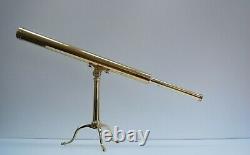
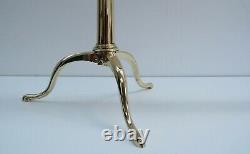
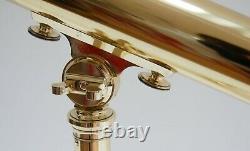
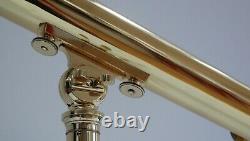

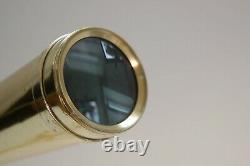
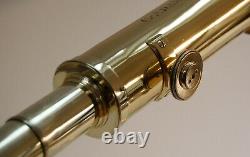
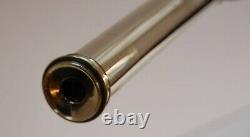


For sale a late eighteenth century achromatic desktop library telescope by George Adams of Fleet Street. A telescope of outstanding quality from one of the foremost London scientific instrument makers of the period, it is comprised of a 29 inch tapering main barrel with a two inch objective couplet lens arrangement, a rack and pinion movement for fine focussing and the makers name G.
Adams, London expertly engraved to the top of the tube. The fine focus rack and pinion movement operates a short 2 inch draw tube with a further hand adjustable 16 draw tube incorporated within, making a fully extended length of around 46 inches and maintaining good optics. The body of the telescope is rested upon a solid brass 16 inch high tripod base with tapering shaft upon articulated legs. The sheer quality and attention to detail of this piece is unmistakable from the tripod feet reminiscent of furniture from the period, to the knurled screws that affix the telescope to its base and for the lightness of touch to the instrument itself. This level of craftsmanship simply does not exist anymore, and is a sheer pleasure.
Although the output of George Adams Senior and George Adams Junior is often difficult to distinguish, the telescope was almost certainly manufactured by the son of this famous dynasty given that it contains an achromatic lens. George Adams Senior was born in Fleet Street, London in 1709 to a Morris and Mary Adams. His Father was a freeman of London and belonged to the Loriners Company and although he was a liveryman, was actually a cook by trade. His initial two years were not without difficulty as his father Morris died the following year leaving George, his mother Mary and two further children without support and the following year also saw the death of his master. By good fortune, George was turned over to a new master Thomas Heath who had by then been trading on The Strand for just six years but ran a successful and enterprising establishment and his adverts from the period attest to the wide range of instruments that the young Adams would have been tasked to manufacture.
On completion of his seven year tenure, he chose to continue his work for Heath, only being granted his freedom of the Grocers Company in 1733 by which point his mother had also passed away. It is likely then that the proceeds of his parents estate was the catalyst for George Adams to begin trading in his own right. The establishment of his business at the sign of Tycho Brahes Head on Fleet Street was close to his home in Shoe Lane but he joined a community of already established scientific instrument makers in that area and could guarantee a certain amount of passing trade from the positioning. He also kept up his ties with Thomas Heath which is evidenced from dual advertisements that were taken out by the pair in the mid-1730s. His prominence as an instrument maker really took off in the 1740s where he began to undertake work for both The Board of Ordnance and The East India Company. It was also the decade in which the microscope began to ascend in its popularity and Adams, seeing an opportunity, undertook to write the first of his two famous publications. This initial publication, Micrographia Illustrata was introduced in 1746 at the same time as his New Universal Microscope and must have been timed to support his instruments release to the market but the book was in its majority a compilation of many previously known publications but served to provide his audience with instruction and a full account of the possible uses to which this instrument could be applied. By 1750, Adams had also picked up the accolade of supplier to the Royal Mathematical School (then part of Christs Hospital) and had also been elected to the livery of The Grocers Company alongside his old master Thomas Heath and fellow instrument maker, John Gilbert. His short relationship with the mathematics teacher Richard Jack also provided Adams with his only patent for a quadrant and a new refracting telescope which was widely advertised as exceeding the magnification power of any of its competitors. Adams claim brought him into direct conflict with the young (and perhaps equally famous for his involvement in the Dollond achromatic lens affair) Francis Watkins of Charing Cross. Watkins publicly challenged Adams and Jack to a test of this instrument against his own in 1752, an affair that ultimately led to the pair being exonerated much to Watkins chagrin. By 1757, the young George III had reached the age of eighteen and took the position of Prince of Wales and Adams benefitted from this change of events in the Royal Household by receiving his first Royal Appointment. His new title as, Mathematical Instrument Maker to his Royal Highness the Prince of Wales would have immediately increased the level of trade had it not been for a further setback in the form of a fire which ravaged numerous premises on Fleet Street including his own. It wasnt until the end of the year that the ever labouring Adams had managed to open in alternative premises on Fleet Street and circumstances must have proved encouraging enough for him to have taken the position of Junior Warden in the Grocers Company in 1758. With the accession of George III to the throne in 1760, George Adams by default became a provider of scientific instruments to His Majesty the King and the same decade saw Adams begin the production of globes, a product which has come to be a recognised and highly regarded part of the companys output. By 1766, Adams also released his second famous publication, A Treatise Describing and Explaining the Construction and Use of New Celestial and Terrestrial Globes. In similar circumstances to his previous output on microscopes, it was timed to support his new creations and his dedication of the book to The King would have been added some further momentum to the exercise. Adamss son, George Adams the younger had also by 1765 become apprenticed to his Father so the marketing exercise would have provided first hand evidence to Adams the Younger of the power of the printed medium. In October of 1772, George Adams died at the age of sixty three, he had spent the last six years of his life largely dedicated to the updating and republication of his two most famous works. His son, George the younger had finished his apprenticeship but had not applied for his freedom and therefore had to move quickly in order to maintain the family business. His mother Ann had been left in control of the firm as a result of the content of her husbands will and the urgency is clear from existing advertisement which seek to make it clear that Ann & George Adams, continue to carry on the business of the late Mr Adams. The work seemed to continue unabated but the Board of ordnance work fell away in the short term and was taken over by a Jeremiah Sissons who was already known to them through his work with The Royal Observatory, nevertheless, Adams the younger lost no time in clearing up the affairs of his father and immediately applied for his livery in the Grocers Company which was awarded in early 1773 and he took on his first apprentice, Fowler Bean in June of the same year. In 1774, Adams was married to Hannah Marsham and this event must have caused some household complications for the young scientific instrument maker as the home and shop premises at 60 Fleet Street were also presumably housing his mother and Adams siblings (notably his younger brother Dudley) all of whom were dependent on the business. The living arrangements remain unclear but by the end of the decade Adams had re-engaged his services to The Board of Ordnance, taken on his brother Dudley as an apprentice in 1777 and another in the same year named Christopher Steadman. With Fowler Bean finishing his apprenticeship in 1781, Adams also took on his half nephew Robert Blunt Junior.Blunts relatives maintained their links with the Grocers company throughout the twentieth century owing to their close ties to the Adams blood line. By the mid-1780s, Adams younger brother Dudley left his older siblings workshop to set up his own establishment in Charing Cross and concentrated on the manufacture of Globes.
The globe plates left in George Adams Seniors will were owned by his widow so it is likely that she reserved this benefit for Dudley. It is certainly true that any Adams globes after this period are signed to Dudley Adams and he is also likely to have provided stock to his brother for resale at the Fleet Street premises. It is perhaps unsurprising given that George Adams Juniors attention began to turn squarely on the written word as a means to promote his business. The lessons learnt to him by his fathers activity must have encouraged this activity and he became a prolific writer of essays on all manner of scientific subjects until his death. The subjects ranged from electricity, microscopy, astronomy, meteorology and geometry and these publications provide the historian with a vast amount of useful information on the types of instruments being manufactured during the latter part of the eighteenth century.
Adams, like his father, died early at the age of forty five in august of 1795 leaving the Fleet Street business to his wife. Hannah Adams evidently had every intention of continuing her husbands business but without offspring she was entirely alone in managing the family affairs and Georges early death meant that his Mother was still alive and therefore retained some rights to the business by virtue of her husbands will. The acrimonious nature of the following events is borne out by Dudley Adamss immediate application to The Board of Ordnance with the intention of picking up his older brothers commission. He was quick enough in this undertaking to beat Hannahs similar communication and ultimately took over the work shortly after. Without children, her estate fell back into the hands of the Marsham family.
Owing to the complicated situation of the inheritance, the shop at Fleet Street seems to have remained in the hands of the Adams family and Dudley vacated his Charing Cross premises in 1796 back to the original shop at the sign of Tycho Brahes Head. He maintained a good industry standing for some years and is known to have received patents for three instruments during his remaining years of trading. His story is one of slow decline though and his loss of the Board of Ordnance contract in 1806 was the beginning of the end which ultimately led to bankruptcy in 1817. Records suggest that Dudley Adams may have become somewhat unhinged by his ever worsening situation and his entreaties to the Grocers Company and to the Earl of Liverpool in and around 1818 and 1819 bear testament.Thereafter, he seems to have involved himself in the new science of electricity and began writing essays on the subject from his new premises at 42 St Pauls Churchyard and 22 Ludgate Hill where he established his Medico-Electrical Institution and convinced of the medical possibilities of this new science began to treat patients. Dudley died at some point between 1827 and 1830 and the lack of any records suggest that he died penniless, a somewhat sober ending to the powerhouse of scientific instrument makers that were the Adams dynasty. Their instruments however still bear testament to the superior quality and attention to detail to which was applied to their products. This particular example of George Adams Juniors work is as good as one should expect and although this familys work is always difficult to date, is likely to have been conceived in the period between 1780 and 1790.
Jason Clarke Antiques are happy to discuss carriage, condition or for any other queries, alternatively, you can also message me and I will endeavour to come back to you as soon as possible. I have a number of beautiful antiques for sale, so please feel free to browse my other items. The item "EIGHTEENTH CENTURY DESKTOP LIBRARY TELESCOPE BY GEORGE ADAMS OF FLEET STREET" is in sale since Monday, February 18, 2019.
This item is in the category "Antiques\Science/Medicine\Scientific Instruments". The seller is "jason750_1" and is located in newbury, Berkshire. This item can be shipped to United Kingdom.- Material: Brass
- Type: Telescope
- Period: Pre 1800

